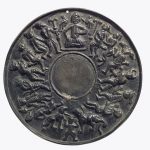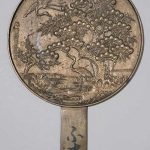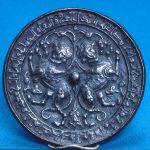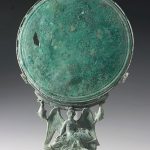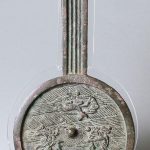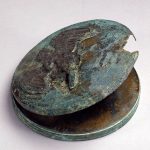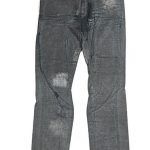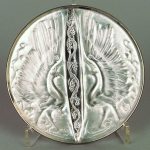Bronze mirrors preceded the glass mirrors of today. This type of mirror, often incorrectly termed a copper mirror, has been found by archaeologists among elite assemblages from various cultures, from Etruscan Italy to China. Reference: Wikipedia. Below are some examples of bronze mirrors.
Mirror 12th–13th century Cast bronze mirrors were often used for divination or magical medicine. The polished metallic front provided a reflective surface. Often, the decoration on the back depicted the zodiac or mythological themes. The scene on this mirror is interpreted as Solomon and his demons.
Reference: The Metropolitan Museum of Art
‘Magic’ mirror Made by in Japan, Asia, 1886. A ‘Magic’ mirror, made of bronze. On the back it is decorated with relief, representing mythological persons, birds, flowers &c. This is done after the front of the casting has been polished off till from 0.5 to 2.5 millimetres thick, and finally coated with an amalgam, which is composed of from one to two parts tin, and one part of quicksilver. There is at one side a staff shaped handle with which it is held. When it reflects the sunlight on the wall, it mirrors at the same time the raised figures on its back, more or less distinctly. Japan. A case for ‘magic’ mirror, made of wood. Case is in the shape of the mirror and includes a base and two lids.
Reference: Museum of Applied Art and Sciences
Bronze mirror Persian; MesopotamianSeljuk12th–13th centuryObject Place: Khurasan, Iran
Reference: Museum of Fine Arts Boston
A Greek Bronze Mirror, 4th Century B.C. of circular form with ribbed concentric bands on the reverse, the handle in the form of winged Eros riding a dolphin and holding the dorsal fin with his left hand, his right hand resting on folds of drapery, his hair bound in a topknot, one eye with remains of inlay, two inverted diminutive dolphins flanking the wings. Height with tenon 11 7/8 in. 30.1 cm.; Diameter 7 5/16 in. 18.5 cm.
Sold for 15,000 USD at Sotheby’s in 2013
Bronze mirror with circular shape, thick raised edge, pierced central boss and handle, decorated in the centre with two heavenly creatures wearing floating garments and holding branches of magic fungus and coral, and a single-horned animal seated on an island in the waves and gazing at a crescent moon; the clouds in the sky are ruyi-shaped. The handle has a thick raised edge and is decorated within the edge with four flutings.
Hand-mirrors with handles were used in ancient China and mentioned in historical texts, but they are less frequent than other types intended to be mounted on stands and placed on dressing tables. The scene depicted on the back of this example combines Daoist mythological elements symbolising immortality and good fortune. The two figures, holding branches of coral and lingzhi, or fungus of immortality, are celestial immortal creatures living in the heavens; the single-horned animal depicted below them is a deer, symbol of longevity and often represented with the fungus of immortality in its mouth.
Reference: © Victoria and Albert Museum
Mirror with a Bathing Maiden The most popular type of mirror in the Hellenistic period was of “clamshell” form, much like the modern compact. The polished mirror disk was protected by a hinged lid, decorated with figures in relief on the exterior and, not uncommonly, with a scene engraved on its underside. Appearing on the inside lid of this mirror is a tranquil scene with a nude maiden, perhaps Aphrodite or a nymph, bathing in a rocky grotto.
3rd century BC (Hellenistic)
Reference: The Walters Art Museum
